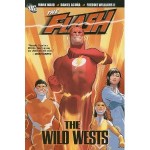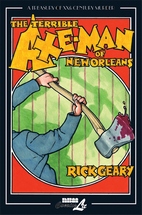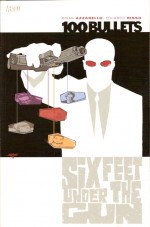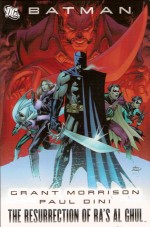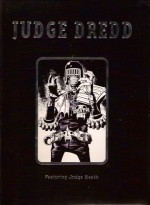
By John Wagner & Brian Bolland (Titan Books)
ISBN: 978-1-84023-386-5
Britain’s last great comic icon could be described as a combination of the other two, combining the futuristic milieu and thrills of Dan Dare with the terrifying anarchy and irreverent absurdity of Dennis the Menace. He’s also well on the way to becoming the longest-lasting adventure character in our admittedly meagre comics stable, having been continually published every week since February 1977 when he first appeared in the second issue of science-fiction anthology 2000AD.
However with at least 52 2000AD strips a year, annuals, specials, a newspaper strip (in the Daily Star and later The Metro), the Judge Dredd Megazine, numerous reprinted classic comics collections and even two rather appalling DC Comics spin-off titles, that adds up to a phenomenal amount of material, most of which is still happily in print.
One of the nicest looking packages and certainly one of the most inviting for new readers is this sharply stylish black and white deluxe hardcover collection featuring some of the formative work of superstar artist Brian Bolland.
Bolland by his own admission was an uneconomically slow artist and much of his Dredd work appeared as weekly portions of large epics with other artists handling other episodes, but all the cases collected here are self-contained or short continued sagas, resulting in a wicked compendium of his best, funniest and most striking material all in one magnificent volume.
FYI: Dredd and his dystopian ultra-metropolis of Mega-City One were created by a committee including Pat Mills, Kelvin Gosnell, Carlos Ezquerra, Mike McMahon and others but with the major contribution coming from legendary writer John Wagner, who has written the largest portion of the canon under his own and several pseudonymous names.
Joe Dredd is a fanatically dedicated Judge in the super-city, where hundreds of millions of citizens idle away their days in a world where robots are cheaper and more efficient than humans and jobs are both beloved pastime and treasured commodity. Boredom has reached epidemic proportions and almost everybody is just one askance glance away mental meltdown. Judges are peacekeepers who maintain order at all costs: investigating, taking action and trying all crimes and disturbances to the hard-won equilibrium of the constantly boiling melting pot. Justice is always immediate…
They are necessary fascists in a world permanently on the edge of catastrophe, and sadly, what far too many readers never realise is that the strip is a gigantic satirical black comedy with oodles of outrageous, vicarious cathartic action.
In Prog (that’s issue number to you) 149-151 (January 26th – February 9th 1980), with the continuity firmly established Wagner, writing as John Howard, introduced ‘Judge Death’, undead lawman from an alternate Earth, where the Judges, when faced with the same problems as our world took their creed to its only logical conclusion: If all crime is perpetrated by the living then to eradicate crime…
With all life ended in his own dimension the ghostly ghoul extended his mission to ours, wiping out criminals and law-abiding citizens alike, with the Judges – even Dredd – unable to stop him until the flamboyant and unconventional psychic hottie Judge Anderson of PSI Division sacrificed herself to trap the evil spirit forever…
As if…
With Wagner clearly on a creative roll the fans spoke long and loud and thus both the Zombie Peacemaker and Anderson were returned within a year in the manic mayhem of ‘Judge Death Lives’ (credited to T.B. Grover but still Wagner really; Progs 224-228, August 8th – September 5th 1981), as a desperate citizen released the horror from his eternal tomb at the behest of three more expired Judges: Mortis, Fire and Fear.
Reunited with their leader the Dark Judges went about their duty executing all of Mega-City One and it took a trip to their home “Deadworld†before Dredd and Anderson could stop the slayers – albeit temporarily. Both Anderson and Death went on to win their own series…
For a while early on in his career, Dredd was seconded to the Moon to oversee the colony there – which was as bonkers as Mega-City One – in conjunction with Cold War enemies the Sov Judges.
From that period came ‘The First Lunar Olympics’ and ‘War Games’ (Progs 50-51, February 5th and 11th 1978) a vicious swipe at contemporary sport’s politicisation which was and still is bloody, brutal and bitingly funny, whilst ‘The Oxygen Board’ and ‘The Face-Change Crimes’ (Progs 57 & 52, March 25th and February 18th 1978 respectively) are hilariously inventive bank-raid capers with the kind of mordant twists which elevated Dredd so far beyond all other cop and sci-fi strips.
Once rotated back Earthside it was business as unusual in ‘The Fog’ (Prog 127, August 25th 1979) a chillingly atmospheric pastiche of horror film classic House of Wax, whilst in ‘The Forever Crimes’ (Prog 120, July 7th 1979) Dredd showed that being dead was no valid reason for a perp to avoid his sentence and this spectacular chronicle ends with the glorious insane ‘Punks Rule!’ (Prog 110 April 28th 1979), an epilogue to the epic Judge Caligula story-arc, with the Judges slowly resuming control of Mega-City One after a civil war and revolution, with Dredd personally stamping out street gangs that had carved out their own little empires in the aftermath.
Beautifully drawn these are perfect short stories starring modern Britain’s most successful and iconic comic character: timeless classics that no real comic fan can ignore – and just for a change something that you can easily get your hungry hands on…
® & © 2001 Rebellion. All rights reserved.


